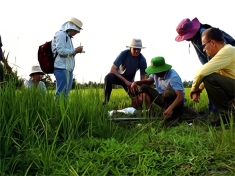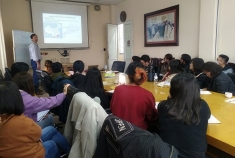Microbiology of Arsenic-Contaminated Agricultural Soils in the Mekong River and Red River Deltas

Max Häggblom (Department of Biochemistry ad Microbiology) and John Reinfelder (Department of Environmental Sciences) visited Vietnam to initiate collaborative research on microbial arsenic metabolism in rice paddy soils with investigators at Can Tho University, College of Agriculture and Hanoi University of Science and Technology, School of Biotechnology and Food Technology.
Arsenic (As) contamination of groundwater is of serious concern in many regions of Southeast Asia, including Vietnam, and is linked to As contamination of paddy soils, which threatens the health of populations relying on rice as a staple crop. Rice consumption is a key pathway for the dietary intake of both essential trace elements and toxicants, including As which is harmful to human health.

Although generally present in the environment at low levels, As is actively metabolized by microorganisms, a process that has a strong impact on its mobility and bioavailability. Microbially mediated transformations modulate the toxicity of As and change its mobility and bioavailability, which in turn may affect its translocation and accumulation in plants. Hence, microbial transformations of As can have a direct effect on the nutritional quality of various crops, especially rice. In pilot experiments we aim to cultivate and isolate As-respiring bacteria from agricultural soils in the Mekong and Red River watersheds to obtain site-specific reference strains for physiological characterization and for use in molecular monitoring of community dynamics and activity. With our collaborators we will design a combination of greenhouse experiments and field site analyses comparing water management and rice cultivation methods to demonstrate the activity of As-reducing microbes under in situ conditions and determine how their abundance and activity are affected by changes in the redox environment and differences in site water and soil chemistry.